Art & Exhibitions
David Ebony’s Top 10 New York Gallery Shows for November
Don't miss Francis Bacon, Joan Mitchell, and Josh Tonsfeldt.

Don't miss Francis Bacon, Joan Mitchell, and Josh Tonsfeldt.

David Ebony

1. Joseph Kosuth at Sean Kelly, through December 19.
Among the most cerebral of artists, conceptualist maestro Joseph Kosuth is best known for austere installations using appropriated images and texts referencing philosophy, psychoanalysis, and cultural theory, often incorporating glowing neon lettering. In this stunning show, “Agnosia, an Illuminated Ontology,” the New York- and London-based artist covers all the walls, and even the ceiling with vibrant and colorful neon pieces that he created over a period of more than fifty years.
As an encapsulated retrospective, the show is a bit overwhelming at first. The gallery, however, provides a hand-out map to help viewers navigate the dense and intense installation, with commentary about each work. Among the exhibition’s highlights are several early efforts of the 1960s, such as Five Fives (to Donald Judd) (1965), a minimalist composition consisting of five rows of numbers—from five to 25—spelled out in glowing cobalt neon. The 2009 Paradox of Content series is more baroque in feel, with swirling graphics and cursive lettering in orange neon channeling the works of Nietzsche and Darwin.
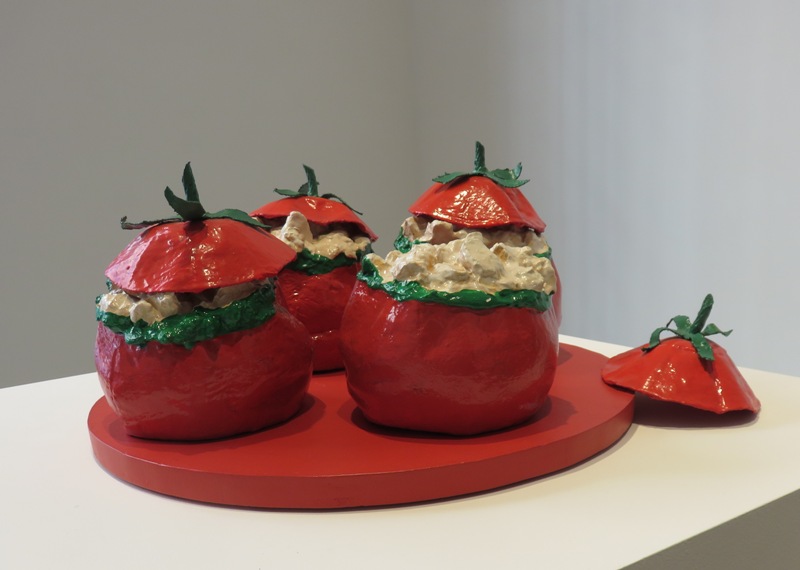
Claes Oldenburg, Tomates Farcies, 2015.
Photo: Courtesy Paula Cooper Gallery.
2. Claes Oldenburg & Coosje van Bruggen at Paula Cooper, through December 12.
Featuring some 100 sculptures and drawings spanning over forty years, “Things Around the House” is a fine tribute to Claes Oldenburg—a living legend at 86—and his late wife and collaborator Coosje van Bruggen (1942-2009). In a press statement that accompanies the exhibition, Oldenburg says that the objects and drawings on view are works that somehow managed to stay with him over the years, filling his Manhattan loft. The works, related to many well-known exhibitions, are those that the artist could not part with, or were left unsold. For that reason, the show constitutes a rather concise and thorough retrospective, highlighting some celebrated Pop art classics, such as his oversize pieces Soft Key (1965), made of canvas stuffed with kapok, and the giant Light Switches (soft and hard versions) (1964-71).
Oldenburg’s collaborations with Van Bruggen, from the mid 1970s on, tend to convey more complex narratives, as well as architectural forms, as in Houseball, Naoshima—Presentation Model (1992), a resin-coated bundle of miniature household items; and Gazebo, a model for a space-age structure whose roof is supported by posts in the form of pretzel sticks. Oldenburg is widely regarded as Pop art’s premier draftsman, and his meticulous and imaginative renderings of giant screws, colossal saxophones, and slices of blueberry pie, are among the show’s highlights. One of the most charming and endearing sculptures on view is the recent Tomates Farcies (2015), a cluster of four canvas-and-resin tomatoes painted a brilliant red. Forever fresh and savory, these stuffed tomatoes correspond to similar food items made of painted plaster that Oldenburg created early in his career, for “The Store,” a landmark 1961 exhibition and Happening in New York.

Brice Marden, Uphill with Center, 2012-2015.
Photo: Courtesy Matthew Marks Gallery.
3. Brice Marden at Matthew Marks, through December 24.
This refined exhibition of 12 recent paintings and 25 drawings is full of surprises. It represents something of a watershed moment for Brice Marden. The austere, monochrome abstractions in muted colors, for which Marden garnered international attention in the late 1960s, have reappeared in the works on view here in unexpected and brilliant ways. The series of serene recent monochromes, such as Over Autumn (2015), with its rich, forest green surface, and the carefully orchestrated band of oil pigment drips against the raw linen near the bottom edge, seems startling in the context of 21st–century Marden. The works, however, are no less potent than their antecedents of some 50 years ago.
One of the most arresting works on view, Uphill with Center (2012-2015) has a rather epic quality, and an autobiographical component. This long, horizontal, five-panel composition, approximately 4-by-16 feet, features at its center one of Marden’s Zen calligraphy-inspired compositions, typical of those painted in recent years, flanked by four monochrome panels, two on each side, that recall Marden’s much earlier efforts. The central panel’s ethereal gray ground is enlivened by interweaving networks of sensuous lines in red, green, blue, and yellow, which correspond to the monochrome hues of the side panels. A key work that in certain respects sums up Marden’s achievement to date, the painting seems to forge ahead toward an entirely new horizon.
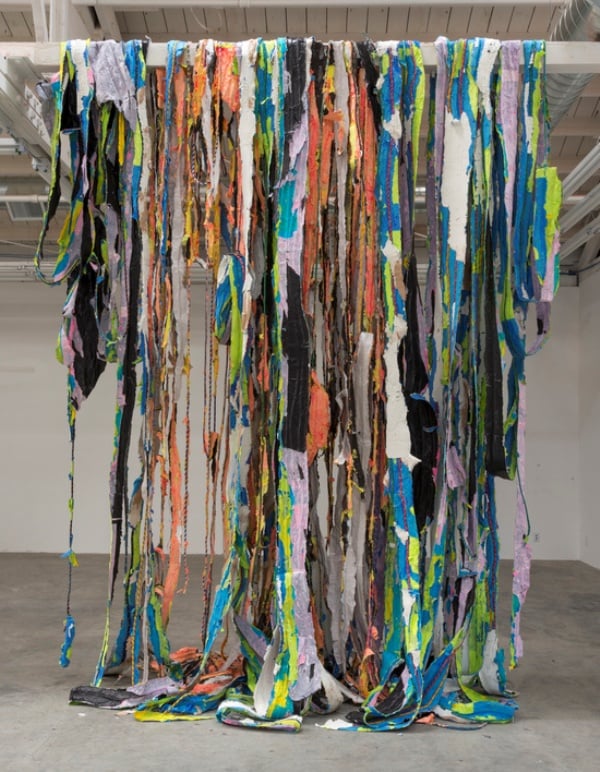
Mark Bradford, Waterfall, 2015.
Photo: Courtesy Hauser & Wirth.
4. Mark Bradford at Hauser & Wirth, through December 23.
Street smart and art-historically savvy, the recent paintings and installations in this exhibition, “Be Strong Boquan,” are among Mark Bradford’s best. In a number of pieces such as the multimedia work, Spiderman, which features the show’s fictional title character, and the video, Deimos, which evokes the end of a party at a 1980s roller disco, the LA-based artist touches on themes of race, gender identity, and the AIDS epidemic.
At the heart of the show are the large-scale abstract paintings, whose densely textured surfaces and sumptuous colors are achieved by means of countless layers of pigment and paper bits applied and pulled off the canvas in a painstaking collage-and-decollage process. One of the most impressive compositions, Walk to the Middle of the Ocean (2015), features billowing passages of blue and white that indeed convey crashing waves in some imaginative nautical upheaval. Continuing the aquatic theme, Bradford’s Waterfall (2015) is a painting-sculpture hybrid made of dozens of long, colorful strips of painted and collaged canvas, like outtakes from the 2D paintings. Draped over a ceiling-mounted beam, the streams of fabric cascade to the ground. There’s nothing remotely realistic about this fanciful “waterfall,” yet it somehow relays a convincing and dramatic ode to nature’s most vital and increasingly endangered resource.
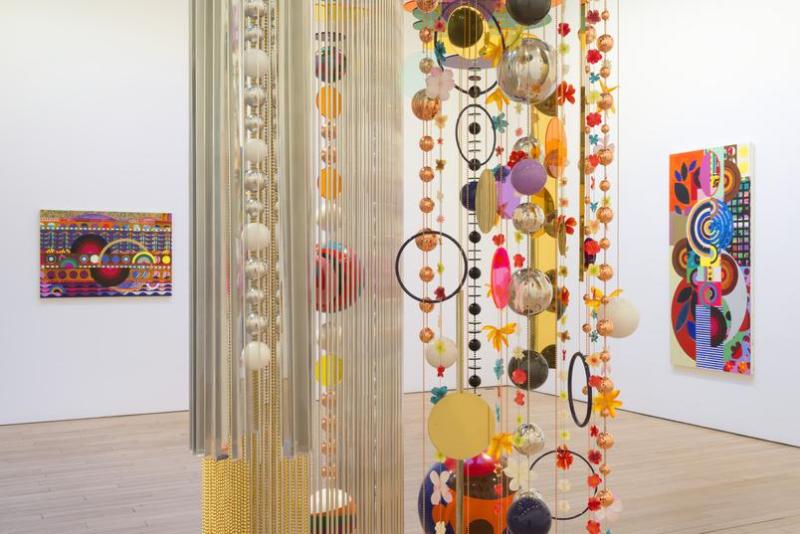
Installation view, Beatriz Milhazes, “Marola,” 2015.
Photo: Courtesy James Cohan Gallery.
5. Beatriz Milhazes at James Cohan, through November 28.
Brazilian artist Beatriz Milhazes, based in Rio de Janeiro, is internationally renowned for her distinctive abstract paintings that feature elements of her hometown vernacular, including the raucous decorative items associated with Carnival. Early on in her career, she referenced feminist issues in Latin American art by incorporating in her vibrant compositions details of colonial-period women’s clothing and jewelry. The shapes are relatively more hardedge and the colors more strident in her latest works on view in this show, “Marola,”whose title refers to the ripples that follow a large wave.
In the expansive, resplendent paintings here, such as Maracorola (2015), circular shapes in blue and white appear to spin above a pulsating field of starbursts and narrow strips of scalloped patterning that conjure abstracted waves. Here, Milhazes allies heself with modernist painters like Sonia Delaunay and Sophie Taeuber-Arp. This show is especially significant as it marks the New York debut of Milhazes’s sculptures. These ceiling-hung works made of countless strands of glass beads, with mirror balls, and other embellishments, play off the paintings in a remarkable way. They directly imply the body, movement, and dance. In fact, she first developed these shimmering mobiles as stage props for dance performances by her sister, Márcia Milhazes, a highly regarded choreographer of modern dance in Brazil. They suggest an exciting new direction for Beatriz Milhazes’s art.
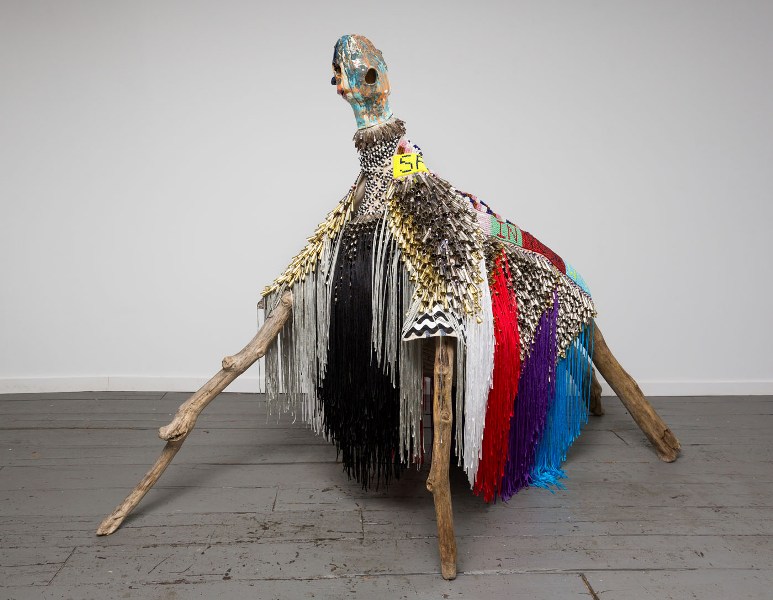
Jeffrey Gibson, Speak to Me in Your Way So I Can Hear You, 2015.
Photo: Courtesy Marc Straus Gallery.
6. Jeffrey Gibson at Marc Straus, through December 13.
Jeffrey Gibson’s exploration of his Native American heritage in his art has led him to a diverse range of formal expression. He has established over the past several years a consistently engaging visual vocabulary that encompasses painting, sculpture, installation, video, and performance. This show is an exciting overview of the artist’s recent endeavors; it includes familiar works, such as several of the elaborately beaded Everlast punching bag pieces, often with text, that suggest an idiosyncratic meditation on violence, or its antithesis, peace.
Among the finest works on view are hard-edge monochrome paintings on rawhide, such as Undercover (2015), with its translucent layering of glowing green bands, and Ebb and Flow (2015), whose striated composition of black and sepia rectangles has an almost Op art feel. Most haunting of all are the two large sculptures, including Speak to Me in Your Way So I Can Hear You (2015), made of driftwood logs adorned with countless strands of glass beads, and brilliantly colored strips of fabric, and fringe. Topped by an abstracted head in glazed ceramic, this uncanny personage conveys a ritual significance, like a shaman figure, at once arcane and prescient.
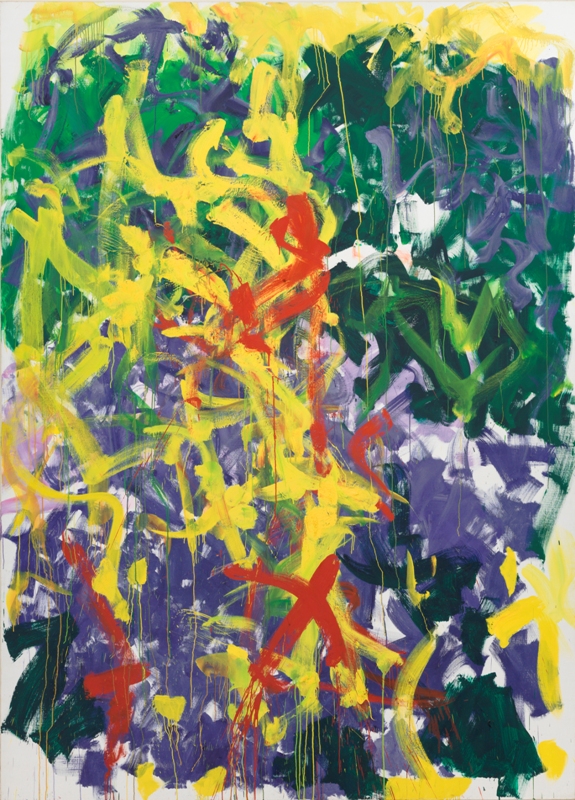
Joan Mitchell, La Grande Vallée XIX Yves,1984.
Photo: Courtesy Edward Tyler Nahem Fine Art.
7. Joan Mitchell at Edward Tyler Nahem, through December 18.
A woman artist grappling with the uber-macho milieu of the Abstract Expressionists in New York in the 1950s, Joan Mitchell more than held her own—in the studio as well as at the bar. In the midst of those hard-driving, heavy drinking days, she managed to develop a style of gestural abstraction that is as muscular and ambitious as anything her peers turned out. By the end of the decade, Mitchell (1925-1992) had established her reputation and relocated to France, where her compositions of lush color and vibrant brushwork further evolved toward a distinctive luminosity and a dynamic rhythmic beat.
This lively New York gallery show, “Joan Mitchell: At the Harbor and in the Grande Vallée,” coincides with a major Joan Mitchell retrospective currently on view at the Museum Ludwig in Cologne (through February 21, 2016). Full disclosure: I was one of the editors of the catalogue related to the New York exhibition, set to be launched at this year’s Art Basel Miami. Curated by scholar Jeffrey D. Grove, the show features eight major canvases representative of two important groups of works.
The first group, a 1950s collection of raw and visceral compositions, demonstrates the painterly chops with which Mitchell built her reputation. The second, later series from the 1980s, features the dazzling canvases known as La Grande Vallée paintings, referencing an imaginative and mystical landscape. Some of the most captivating works here are rather personal visual statements, often dedicated to friends, such as La Grande Vallée XIX Yves (1984), with calligraphic slashes of bright red and chartreuse pulsating against a blue and green ground.

Josh Tonsfeldt, Adrenaline Tattoo, 2015.
Photo: Courtesy Simon Preston Gallery.
8. Josh Tonsfeldt at Simon Preston, through December 20.
The opening salvo in “Adrenaline,” a show of recent works by New York artist Josh Tonsfeldt, is Adrenaline Tattoo (2015), featuring a dreamlike photo image made of UV cured pigment on a large, vertical, irregular rectangular hydrocal panel. The hazy image represents a reclining young man getting the word “adrenaline” tattooed on his chest while checking messages on his cell phone. This rather iconic picture sets the tone for an ultra-cool yet provocative exhibition of sculptures and two-dimensional works offering a thoughtful critique of the digital age.
Tonsfeldt explores a world that that is at once familiar and strange to me. Entropy and ecstasy seem to merge in these works intended for a screen-obsessed audience for which information overload and desire somehow intersect, collide, and procreate. One stunning piece consists solely of a vertically mounted LED TV set, with the outer screen removed. It is shocking to think about the amount of time many of us spend staring at this light source, now rendered as garish, naked, and absurd. I found Tonsfeldt’s untitled wall reliefs of translucent resin panels embedded with found TV components, unnaturally compelling. His untitled, slow-moving abstract video piece contained in a boxlike construction and placed on a shelf, appears as a rather menacing light sculpture. This work, like many of those in “Adrenaline,” is somewhat disturbing, though completely enthralling—and certainly unforgettable.
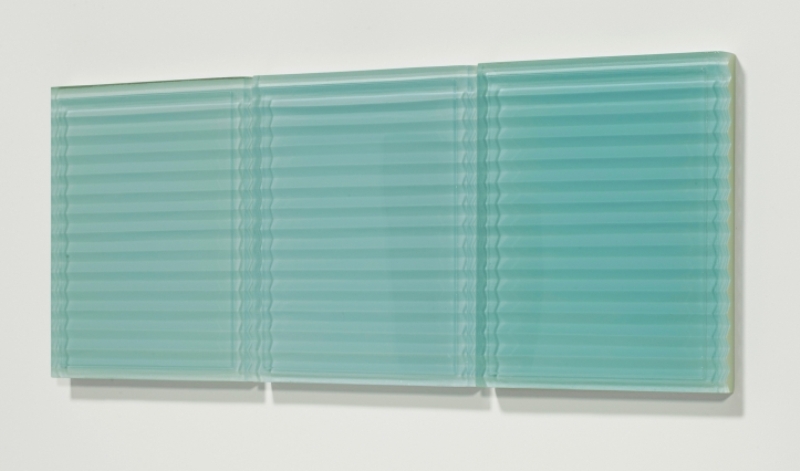
Rachel Whiteread, Untitled (eve III), 2015. Photo: Courtesy Luhring Augustine Gallery.
9. Rachel Whiteread at Luhring Augustine, through December 19.
London-based artist and YBA (Young British Art) survivor Rachel Whiteread is well known for rendering negative space in sculptural form—absence made present, interior made exterior, and invisible made visible. On view through December 20, at Luhring Augustine Bushwick, “Looking Out” features a classic Whiteread sculpture—Detached III, a concrete and plaster cast of a pre-fabricated garden shed, plus related drawings.
“Looking In,” at the gallery’s Chelsea space, is all about air and light. Highlighting recent works in plaster, rubber and resin, the show includes some of Whiteread’s best works to date, such as Untitled (Patched Up) (2015), a ghostly resin cast of a large, incongruously transparent door. Cool and contemplative, Untitled (Curtains) (2015), is a translucent resin door in a mesmerizing and ethereal mauve tone. Of special interest here are the radiant, multi-panel resin casts of accordion blinds, such as Untitled (eve III), in delicate shades of cosmic blue.

Francis Bacon, Self Portrait, 1978.
Private Collection © The Estate of Francis Bacon. All rights reserved. / DACS, London / ARS, NY 2015. Photography by Robert McKeever. Photo: Courtesy Gagosian Gallery.
10. Francis Bacon at Gagosian Gallery, through December 12.
All the hype and hoopla surrounding the bloated market value of Francis Bacon’s work these days—examples of which have sold for over $100 million at auction—sometimes obscures his actual achievement—that of an extraordinarily gifted painter. Bacon is renowned (or notorious, depending on your point of view) for his often brutal distortions of the human figure, which convey the existential angst and rage of his time—and ours. In each work, however, he also offers a nuanced demonstration of his painterly prowess, in which a feverish sequence of brushstrokes can communicate a sensuous and potent life force.
Bacon (1909-1992) painted right up to his last days in Paris and London, before his sudden death in Madrid, at age 82. The quality of his work remained high to the end, as proven by “Francis Bacon: Late Paintings,” a must-see, museum-quality show of some twenty-five major paintings on loan from public and private collections. On view are some classic pieces such as his 1978 Self Portrait showing the twisted figure of the artist writhing against a sumptuous pale blue background. Several of Bacon’s epic, allegorical triptychs are here too as well as more abstract compositions such as Sand Dune (1983), showing an undulating desert landscape set against a searing orange sky. You also have the chance to see one of his best works, and one of my all-time favorites, Jet of Water (1988), featuring a convulsive, painterly tour-de-force that evokes a canon blast of water shooting horizontally across an enigmatic urban vista.
David Ebony is a contributing editor of Art in America and a longtime contributor to artnet.